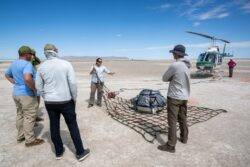Maybe Nasa’s explanation for this one seems a little too convenient… (Picture: Nasa/Twitter)
To the casual passerby, Nasa scientists gingerly examining a flying saucer-shaped object in the desert may be a cause for questions.
However, the team behind Nasa’s OSIRIS-REx mission are simply preparing for a manmade object to return to Earth.
Mission members have this month been rehearsing recovering a mock sample return capsule from the location where the real one will land – along with fragments of asteroid Bennu – on 24 September.
If everything goes according to plan, OSIRIS-REx’s sample return capsule will separate from the spacecraft, enter the atmosphere and parachute safely to the Utah desert for recovery.
Though the team has rehearsed portions of the recovery operation many times this year, this was the most realistic rehearsal yet, taking place at the Department of Defense’s Utah Test and Training Range about 80 miles (130 kilometres) southwest of Salt Lake City.
Besides taking place at the real landing location, the rehearsal included helicopter training for the OSIRIS-REx team members who will fly by helicopter to retrieve the sample capsule from its landing site inside a 36-mile by 8.5-mile (58-kilometre by 14-kilometre) ellipse on the military range.
Rocks and dust, called regolith, were collected from Bennu’s surface in 2020.
Nasa explained: ‘Bennu is likely to be a well preserved, 4.5 billion year old remanent of the early solar system, so the samples should provide insight into the role that similar asteroids played in the formation of planets and the delivery of organic material and water to Earth that may have ultimately led to life.’
The drill will help scientists to prepare for the landing of the actual capsule in two months’ time (Picture: Nasa/Twitter)
Data collected from the OSIRIS-REx mission will also help scientists better understand asteroids that could impact Earth and inform future asteroid deflection efforts.
To investigate these questions, scientists must carefully preserve, protect, and handle the asteroid samples, which will be examined and stored in a new curation facility managed by Nasa’s Astromaterials Research and Exploration Science division, or ARES, at Johnson Space Center in Texas.
The division is home to the world’s most extensive collection of extraterrestrial materials – including lunar rocks, solar wind particles, meteorites, and comet samples.
Get in touch with our news team by emailing us at [email protected].
For more stories like this, check our news page.
To the casual passerby, scientists gingerly examining a flying saucer-shaped object in the desert may be a cause for questions.





